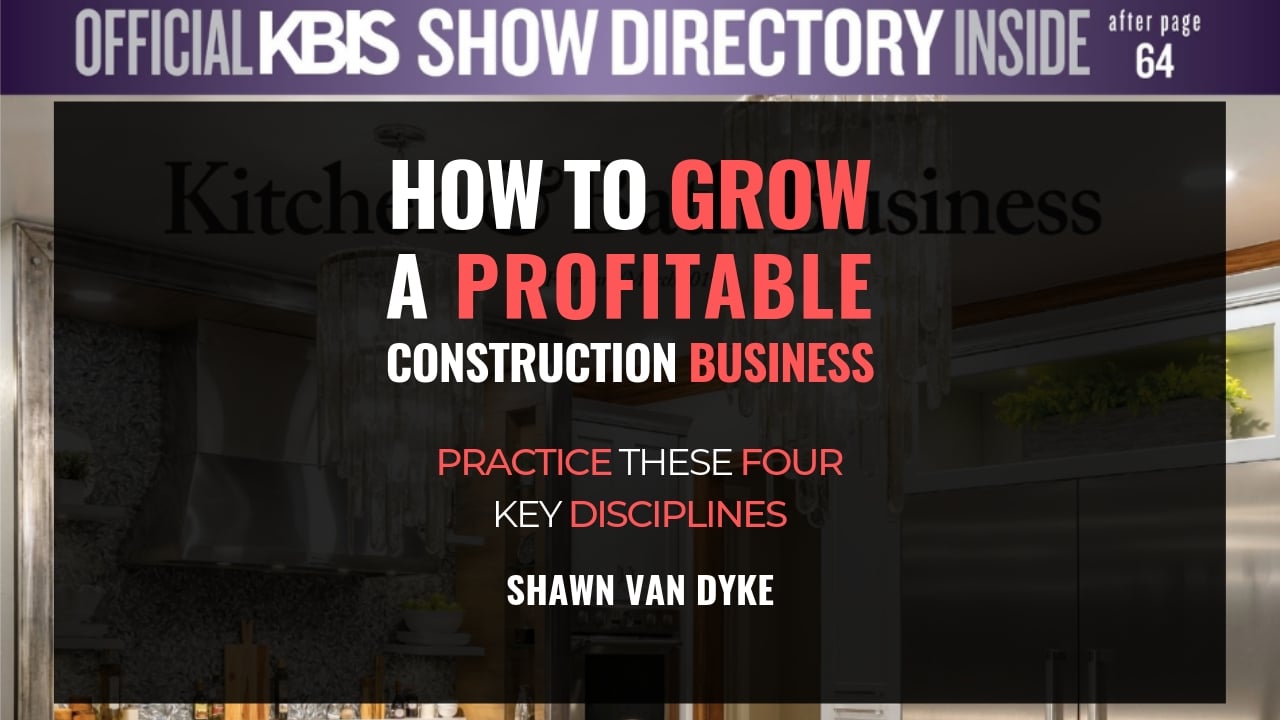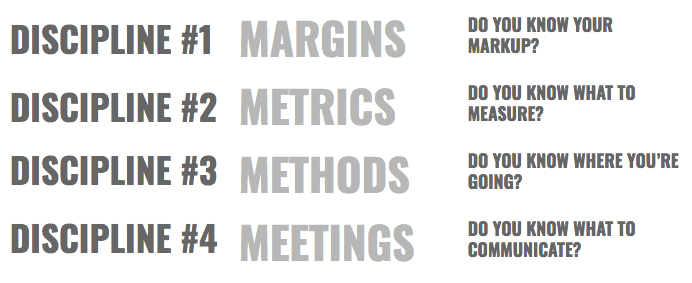Built to Build: Blog
HOW TO GROW A PROFITABLE CONSTRUCTION BUSINESS

Growing a profitable construction business requires more than just increasing the top-line revenue. In fact, selling more work at the wrong price to the wrong customers will ensure that yours never grows in a sustainable manner.
Edward Abbey, an American author and essayist, said,
“Growth for the sake of growth is the ideology of the cancer cell.”
Construction businesses often grow in the same way. The more they sell the more they consume, and the more they consume, the unhealthier they become. Eventually, the growth overwhelms the business’ ability to sustain itself, and it dies.
HOW TO GROW A PROFITABLE CONSTRUCTION BUSINESS – 4 KEY DISCIPLINES
If you want to grow a profitable construction business, you need to focus on these four key disciplines: margins, metrics, methods and meetings.
Margins.
Construction is a cost-based business. You must calculate the cost of the things you buy, mark up those costs to determine your price, and then sell that price to your customers.
Price = Cost X Markup
This is the most important equation for your construction business. The difference between your price and your cost is your (gross) margin.
The margin for your construction business must be enough to pay for your expenses and leave you with a net profit.
I know this may seem elementary, but most construction business owners get this wrong because they guess at their costs and their markup. They don’t understand the difference between costs and expenses and markup and margin, and they don’t understand how to organize and read their Profit and Loss statements.
The costs for labor and subcontractors are skyrocketing because of the labor shortage, and the recent tariffs are also increasing the cost of materials. These cost increases mean construction businesses have to sell their work for a higher price to maintain their margins.
Everything in your business will change except for the math; the math of your business doesn’t change, math is math.
The guesswork you did in the past may have worked for a while, but you can’t guess your way to profitability, you must calculate it. Tracking the activities that produce the margins for your projects is the next key to running a profitable construction business.
Metrics.
Peter Drucker, management consultant and author, once said,
“What’s measured improves.”
If you want to improve your construction business, you must determine the right things to measure.
Labor is usually the largest cost for a construction business.
If you don’t measure your labor in the same way in which you estimate it, you’ll never know if you’re making a profit on your largest cost.
Implementing a labor-tracking system involves establishing billing codes, training your employees on how to fill out their time cards and developing a system to analyze the results. Tsheets, which is owned by Quickbooks, makes time tracking super simple and integrates across many platforms.
The key to any time tracking system is the integration of a billing code system. Each labor line item in your proposal has a quantity of working hours associated with it.
A billing code system assigns a unique identifier (a number) to each of the tasks on the proposal.
When your employees spend time on that task, they report that time on their time cards according to the billing code assigned to that task.
Labor is essentially time, and time is money. Estimating time on tasks becomes extremely accurate when you measure the actual time it takes to perform the tasks. Implementing a standard billing code system will show you exactly where you are making money and where you are losing money. Tracking the metrics of your business is vital to your success.
Methods.
Next, you must develop a method to analyze the data your metrics produce. I call this analysis the “Gravity Versus Frequency Reporting Method.” The basic theory behind the method is this:
The GRAVITY of a report is inversely proportional to the FREQUENCY at which that report is reviewed.
Or in other words…the more often you review a report, the less weight it carries; the less often you review a report, the more weight it carries.
The Gravity Versus Frequency Reporting Method allows you to establish a systematic review of your business’ performance on a weekly, monthly, quarterly and yearly basis.
Using this method, you will be able to determine the progress of your construction business in these four areas:
1. Weekly reports will define the ACTIONS you are taking to drive the day-to-day operations of your business.
2. Monthly reports will identify the TRENDS that occur during the regular cycle(s) of your business.
3. Quarterly reports will track the progress you are making toward your GOALS.
4. Yearly reports will help you determine if you are accomplishing the MISSION of your construction business.
Use this method of reporting to prioritize the flow of information within your construction business so that you can plan for your short-term and long-term success.
When you are clear on the actions (Weekly Reports) that drive your business, you will be able to spot the trends (Monthly Reports) that occur in your business. When you can predict the trends in your business, you will be able to achieve your goals (Quarterly Reports) in a more consistent manner. And when you consistently reach or exceed your goals, you will be able to accomplish your mission (Yearly Report) and grow your construction business.
Meetings.
Accomplishing the mission of your construction business cannot happen without the fourth and final discipline of growth. The problem with producing, analyzing and summarizing the information of your business is that your people don’t know that it exists.
Brad Hams wrote in his book, Ownership Thinking,
“In the absence of information, people make stuff up.”
If you want your team to consistently perform in a certain way, they need to hear the information and see examples again and again and again and again.
Developing a meeting structure will ensure you are communicating your company’s content and intent at every level of the organization. The content is what information your people need to know in order to execute their jobs. The intent is why this information is important.
Communicating content without intent is the difference between merely performing a job and living out a mission.
You need both.
Growing your construction business in a sustainable manner requires discipline, and the disciplines for growth can be summarized as follows:
The Four Disciplines of Profitable Growth for a Construction Company

If you try to scale your construction business without establishing sustainable disciplines for growth, you will also scale your problems. And nothing will kill your construction business faster than small problems that are allowed to grow.
***
This article originally appeared in the KBBOnline.com FEB-MARCH issue which debuted at the NAHB IBS in 2019.
READ THE FULL ARTICLE.
IMPROVE YOUR CONFIDENCE AS A CONSTRUCTION BUSINESS OWNER
Do you want to make more money, streamline your construction business, and get your life back?
If the answer is “YES,” then sign up for one of my coaching programs.
Click here and fill out the application. My team will follow up with the next steps.
GET YOUR COPY OF PROFIT FIRST FOR CONTRACTORS
Remember to go buy my book, it’s on Amazon, it’s on Audible, it’s on Kindle, it’s everywhere, Profit First for Contractors.
If you want to streamline your construction business and DOUBLE your profits next month…
download my FREE book: The Paperwork Punch List

Shawn Van Dyke is a construction industry consultant, business coach, and mentor to construction business owners. He is a Brand Ambassador for Fine Homebuilding, travels across the US as a keynote speaker, seminar presenter, and the author of two books – Profit First for Contractors and The Paperwork Punch List: 28 Days to Streamline Your Construction Business.
WANT SHAWN TO SPEAK AT YOUR EVENT OR TRAIN YOUR TEAM?
